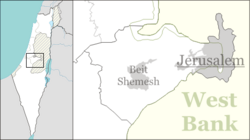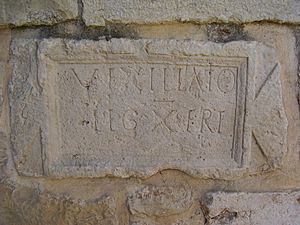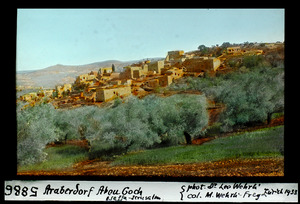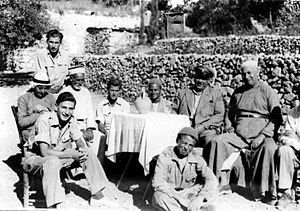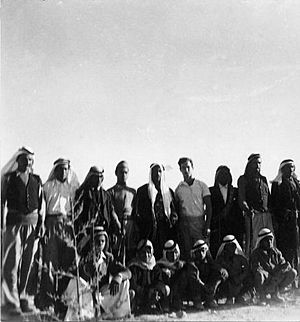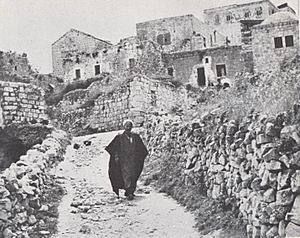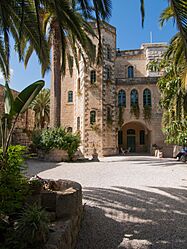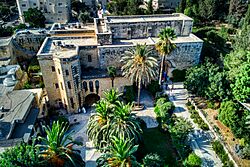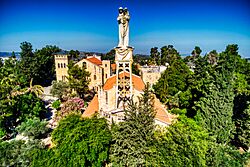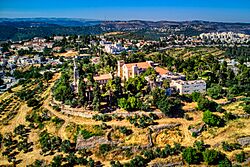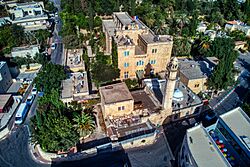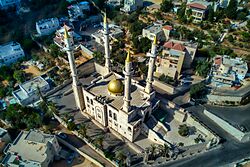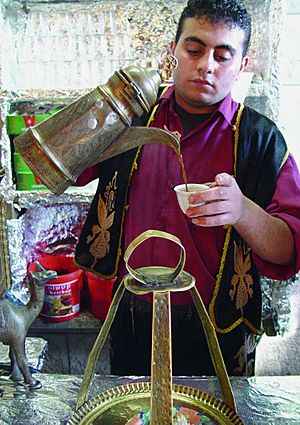Abu Ghosh facts for kids
Quick facts for kids
Abu Ghosh
|
||
|---|---|---|
|
Local council
|
||
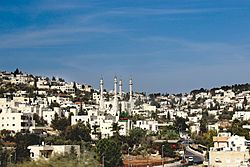 |
||
|
||
| Country | ||
| District | Jerusalem District | |
| Founded | 7000 BCE (earliest settlement) 16th century (Abu Ghosh clan arrives) |
|
| Area | ||
| • Total | 2,500 dunams (2.5 km2 or 600 acres) | |
| Population
(2017)
|
||
| • Total | 7,332 | |
Abu Ghosh (pronounced Ah-boo Gosh) is a small town in Israel. It is located about 10 kilometers (6 miles) west of Jerusalem. The town sits on a main highway that connects Tel Aviv and Jerusalem.
Abu Ghosh is located high up, between 610 and 720 meters (2,000-2,360 feet) above sea level. The town is named after the powerful Abu Ghosh family (or clan) who live there. Its older Arabic name was Qaryat al-'Inab, which means "Grape Village."
Contents
History of Abu Ghosh
Ancient Times
Abu Ghosh is one of the oldest places where people have lived in Israel. Scientists have found signs of three different Neolithic settlements here. The middle one dates back to about 7,000 BCE, which is a very long time ago!
Biblical Connections
The old name of Abu Ghosh, Qaryat al-'Inab (Grape Village), makes some people think it is the same as the biblical town of Kiriath-Jearim. In the Bible, the Ark of the Covenant was kept in Kiryat Ye'arim for many years.
A scholar named Edward Robinson was the first to suggest this idea. Today, archaeologists who are digging at a nearby site called Deir al-'Azar also believe this connection is very likely.
Roman Era
The Roman army had a station in Abu Ghosh. It was used by the Legio X Fretensis, a famous Roman legion, until the end of the 3rd century CE.
Early Muslim Period
In 1047, a traveler named Nasir Khusraw visited the village. He wrote about a wonderful spring of fresh water that flowed from under a stone. People had built troughs around it for travelers and small buildings for shelter.
Crusader Period
The Crusaders arrived in the area and thought Abu Ghosh was the biblical site of Emmaus. They built a church there. However, they later changed their minds about Emmaus and chose a different location.
Ottoman Rule
The Abu Ghosh family settled in the area in the early 1500s. Some stories say they came from Circassia, a region in the North Caucasus. They were known for being strong and powerful.
The Abu Ghosh family became very important because they controlled the main road from Jaffa to Jerusalem. This was the path that many pilgrims and travelers used. They charged a fee (toll) for people to pass through. Even churches in Jerusalem paid taxes to the Abu Ghosh family.
In 1834, during Egyptian rule, the Egyptian governor stopped the Abu Ghosh family from collecting tolls. This led to a revolt, and their village was attacked. The village was attacked again in 1853 and in the 1860s. Despite these attacks, the Abu Ghosh family remained powerful. They governed 22 villages in the region. Their leader, the sheikh, lived in a grand house that visitors called a "true palace" or "castle."
By 1870, Abu Ghosh had 148 houses and about 579 male residents. The village was seen as a local center of power. In 1914, the first kibbutz in the Judean Hills, called Kiryat Anavim, was founded on land bought from the Abu Ghosh family.
British Mandate Period
In 1922, a census showed that Abu Ghosh had 475 people, mostly Muslims with some Christians. By 1931, the population grew to 601 people.
The leaders of Abu Ghosh had good relationships with the Zionist leaders and local Jewish communities from the early 1900s. Chaim Weizmann, who later became the first president of Israel, was even hosted by the people of Abu Ghosh in 1920.
Abu Ghosh in Israel
1948 War
During the 1948 Arab-Israeli War, the road to Jerusalem was blocked. Getting supplies to the Jewish parts of the city was very difficult. Abu Ghosh was one of the few Arab villages in the area that stayed neutral. The villagers often helped keep the road open for Jewish convoys carrying supplies.
The Haganah, a Jewish defense group, decided not to attack Abu Ghosh. This was because their local commanders had good relationships with the village chief, known as the mukhtar. Many villagers left during the heavy fighting, but most returned home later.
After the war, the Israeli government worked to improve the village's infrastructure. The mayor of Abu Ghosh, Salim Jaber, said in 2007 that their good relations with Israel came from their tradition of being welcoming to everyone, no matter their religion or background.
Martial Law (1949–1966)
After Israel was formed, Abu Ghosh was under strict military rule, called "martial law," until 1966. During this time, the army searched the village often. People who were not officially registered as residents could be sent away.
In 1950, some people from Abu Ghosh were sent across the border. The villagers wrote a letter to the Knesset (Israel's parliament) saying that the army had surrounded their village and taken women, children, and older people away. They said many suffered trying to return. After public concern, most of the villagers were allowed to come back.
21st Century
Today, Abu Ghosh is known as a place where different groups of people live together peacefully. In 2017, it was called a "model of coexistence."
Archaeological Discoveries
In 2017, new archaeological digs started at Deir el-'Azar, near the convent. Scientists found a huge stone platform, about 110 by 150 meters (360 by 490 feet) wide. It had strong walls, 3 meters (10 feet) thick and 6 to 7 meters (20 to 23 feet) high. This platform dates back to the 8th century BCE.
Archaeologists think this ancient structure might have been built by King Jeroboam II of the northern Kingdom of Israel. They believe it shows how powerful his kingdom was over the southern Kingdom of Judah. It might have been an administrative center or even a temple.
Later, the Romans used the hilltop as a camp for their Tenth Roman Legion. They made the platform even bigger, creating a perfect square base for their camp. Remains of a Byzantine church from the 5th century were also found. The name Deir el-ʿAzar might come from Eleazar, a high priest in the Bible who was in charge of the Ark of the Covenant.
Religious Sites
Benedictine St Mary of the Resurrection Abbey
The Crusader church in Abu Ghosh is one of the best-preserved Crusader buildings in Israel. The Knights Hospitaller built this church around 1140. It was partly destroyed in 1187.
In 1899, the French government bought the church. Today, it is run by Benedictine monks and nuns. They hold worship services and welcome visitors. This church is also known as the Church of the Resurrection or Emmaus of the Crusaders.
Church of Notre Dame
The Church of Notre Dame de l'Arche d'Alliance (Our Lady of the Ark of the Covenant Church) was built in 1924. People believe it stands on the site of the house of Abinadab. This is where the Ark of the Covenant was kept for twenty years before King David moved it to Jerusalem.
The church was built on top of an older Byzantine church from the 5th century. You can still see a mosaic floor from that older church. The Church of Notre Dame is easy to spot because of the large statue of Mary holding the infant Jesus on its roof.
-
The statue of Madonna and Child on top of the Church of Notre Dame.
Abu Ghosh Mosques
Abu Ghosh has an old mosque in the town center, close to the Crusader church. It is dedicated to Uzair, who is known as Ezra in the Bible.
A new mosque, called the Akhmad Kadyrov Mosque, was finished in 2014. It is the largest mosque in Israel. It was built with money donated by the government of Chechnya.
-
The new Akhmad Kadyrov Mosque.
Music and Culture
The Abu Ghosh Music Festival happens twice a year, in the spring and fall. Musicians and choirs from Israel and other countries perform in and around the churches in Abu Ghosh. The monks believe these concerts show friendship and welcome. It's a special event where people of different backgrounds come together for music.
Local Food
Abu Ghosh is very popular for its Middle Eastern restaurants, especially for its hummus. Many people, both Palestinians and Israelis, visit the town just to enjoy the food.
In 2007, Abu Ghosh was called the "hummus capital of Israel." In 2010, Abu Ghosh even set a Guinness World Record for making the largest dish of hummus! A restaurant owner named Jawdat Ibrahim organized the event. Fifty Jewish and Israeli-Arab chefs worked together to make a huge dish that weighed over 4,000 kilograms (8,900 pounds).
Chametz Ceremony
Since 1997, a Muslim Arab-Israeli man from Abu Ghosh named Jaaber Hussein has taken part in a special tradition. He signs an agreement with Israel's Chief Rabbis to buy all the state's chametz. Chametz refers to leavened products that are not kosher for the Jewish holiday of Passover.
This agreement allows the state to follow religious rules without wasting a lot of food. Hussein pays a small deposit for millions of dollars worth of chametz from state companies and emergency supplies. After Passover ends, the deposit is returned, and the State of Israel buys back all the food.
Images for kids



